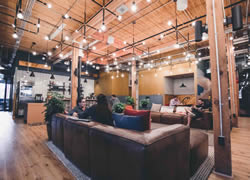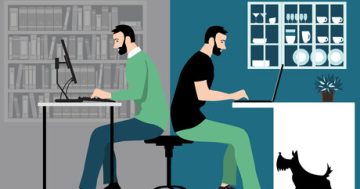Marie Puybaraud* says improving employees’ comfort and flexibility in the work space is a demonstration of trust that will be rewarded with increased engagement and loyalty.

Photo: Eloise Ambursley
Games rooms, contemplation suites and rooftop running tracks.
These may sound like modern innovations — emblematic of the workplace of 2018 — but employers have been experimenting with their workplaces for some time.
Take the US Justice Department under Robert Kennedy as an example.
A gym on the roof, picnic tables in the courtyard and the staff’s dogs in the office were all some of the measures that Kennedy implemented.
What was the result?
A huge boost in morale, according to his biographer, Larry Tye.
In fact, almost 50 years on, Tye reports that “nearly all of his surviving band of brothers say working for Bobby was the high point of their professional lives.”
Kennedy not only boosted morale, but, crucially, he captured the trust and enthusiasm of his employees and was rewarded for it with their loyalty.
Here lies the crux of the matter: it is not only the employees who regularly don their running shoes that benefit from the running track.
It is not just what the running track allows employees to do, but what it represents: a trust in staff that they will spend their time at work responsibly and that they are not chained to their desks.
This really is crucial; building trust is the most effective way for employers to drive up engagement levels, according to our research based on a survey of over 7,300 employees across 12 countries.
Boosting feelings of trust, according to nearly 40 per cent of respondents, would have a very positive effect on their engagement level.
Kindness by management (32 per cent) and letting staff take initiatives without fear of being judged (31 per cent) come next.
How does design demonstrate trust?
In all three areas, most employers have significant ground to be gained.
So, what can they do to turn these abstract ideas into changes that are appreciated by staff?
Trust comes in different ways — open-plan offices, for instance, in which all seniority levels mix together; community spaces (from attractive in-house cafés to lounges); and trusting staff enough to let them choose their working pattern, how to reconfigure their workspace and how to work flexibly.
It is no coincidence that our research also shows that while employees are ready to embrace change and contemplate an agile way of working, with 76 per cent of workers globally ready for some type of change to their workplace, maintaining their personal comfort remains a priority.
Caring about the wellbeing of your employees is one way to demonstrate kindness — using high-quality materials in desks, chairs and overall design, for instance; helping employees stay healthy with a nutrition plan through high-quality supplies for food in the canteen and providing access to anti-stress facilities such as quiet zones and meditation rooms.
But, it is also about fostering trust in employees to use their time effectively, providing a range of working locations and empowering people with greater flexibility over how, where and when they work.
But what can employers actually do?
The transformational effect of trust building in the workplace does not require huge budgets.
It requires human leadership teams who are ready to make employees’ working days better days to be an efficient and happy person at work.
Research from the UK bank HSBC highlights that flexible and remote working is not only on the rise, but nine out of 10 employees claim that remote working is their number one motivator to boost their productivity at work.
Whether you identify a dedicated space — or simply clear corners of the office and add a sofa to provide more informal spaces — community or collaboration areas ensure that employees are able to step away from their desks to recharge and connect with their colleagues.
Flexible spaces are stimulating, creative, inspirational and, perhaps most importantly, as the research demonstrates, capable of boosting productivity.
As for letting people use their initiative freely, encourage them to make suggestions (and also to make and learn from errors) on a wide range of issues, from improving productivity to new workplace systems to the design and layout of the premises.
Including your staff in the process from the outset will also give them the confidence to suggest any changes to the workplace they feel the organisation needs.
Not only does this encourage a sentiment of trust between employer and employee, but also means your people cultivate a strong sense of belonging toward their place of work.
After all, more than one-third of the 7,300 employees we surveyed believe that personalisation of the workplace is critical, and over 40 per cent believe they would do their daily work better if they could work from different types of spaces that have been customised for a variety of needs.
If you manage to deliver on these three areas, our research suggests that you will see a rise in engagement.
Staff will be keener to share their insights with others, to learn from colleagues, to grow within the organisation and to be as enthusiastic as if the organisation belonged to them.
The message is clear: the first step is to trust in your staff and the transformation of your organisation is sure to follow.
* Marie Puybaraud is Global Head of Research for JLL Corporate Solutions. She tweets at @mariepuybaraud.
This article first appeared at www.entrepreneur.com.











